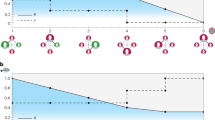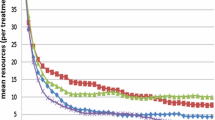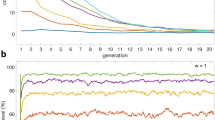Abstract
It is widely recognized that informal monitoring and sanctions foster cooperation in common resource dilemmas. Theoretical models usually assume that agents who punish are those who cooperate on efficient harvesting norms. However, observations from the field show that sanctions are also practiced by those who overexploit the resource. Emotional reasons such as revenge or spiteful motives are suggested to account for this behavior, but none of them insist on economic incentives. Using an evolutionary model, we provide an alternative explanation for the presence of punishing actions undertaken by overexploiters. By assuming that overexploiters have the opportunity to sanction other harvesters, we find that a dual state composed of both cooperators and punishing overexploiters can be stable. Despite the typically negative judgment about such behavior, punishments inflicted by overexploiters may increase cooperation on more efficient harvesting levels. We discuss the implication of this result for resource management.
Similar content being viewed by others
Notes
Eldakar and Wilson (2008), following the usual terminology employed in the biological literature (and sometimes also in economics), call the noncooperators who punish selfish altruists. In fact, cooperating individuals are often considered as altruists, while those who free-ride are selfish. However, in our view, speaking about altruism is unappropriated. It is misleading because both in most of evolutionary models, individuals only cooperate and punish if it is in their own material interest. In this sense, they always act selfishly, whatever outcomes are cooperative or not. Hence, rather than using the words selfishness and altruism, we will stay with the terms cooperation and defection.
This situation where punishers sanction each other could represent a situation of feud. In a public good experiment, Nikiforakis and Engelmann (2011) showed that when free-riders have the possibility to retaliate, cooperators are discouraged to sanction, thereby decreasing cooperation. On the contrary, because sanctions are performed by noncooperators, it may have a positive effect on cooperation here since the costs related to sanctioning activities are borne by the former.
The imitation behavior is largely supported by theory and experimental evidence (see for example Apesteguia et al. (2007).
References
Apesteguia J, Huck S, Oechssler J (2007) Imitation: theory and experimental evidence. J Econ Theory 136:217–235
Baland JM, Platteau JP (1996) Halting degradation of natural resources: is there a role for rural communities? Food and Agriculture Organization, Rome
Casari M, Plott CR (2003) Decentralized management of common property resources: experiments with a centuries-old institution. J Econ Behav Organ 51:217–247
Eldakar OT, Wilson DS (2008) Selfishness as second-order altruism. Proc Natl Acad Sci 105:6982–6986
Falk A, Fehr E, Fischbacher U (2005) Driving forces behind informal sanctions. Econometrica 73:2017–2030
Fehr E, Gächter S (2002) Altruistic punishment in humans. Nature 415:137–140
Gibson CC, Williams JT, Ostrom E (2005) Local enforcement and better forests. World Develop 33:273–284
Masclet D, Noussair CN, Villeval MC (2009) Threat and punishment in public good experiments. CIRANO, Scientific Publication No. 2011s-08
Nakamaru M, Iwasa Y (2006) The coevolution of altruism and punishment: role of the selfish punisher. J Theor Biol 240:475–488
Nikiforakis N, Engelmann D (2011) Altruistic punishment and the threat of feuds. J Econ Behav Organ 78:319–332
Noailly J, Withagen CA, van den Bergh JCJM (2007) Spatial evolution of social norms in a common-pool resource game. Environ Resour Econ 36:113–141
Noailly J, van den Bergh JCJM, Withagen CA (2009) Local and Global Interactions in an Evolutionary Resource Game. Comput Econ 33:155–173
Ostrom E (1990) Governing the commons. Cambridge University Press, Cambridge
Ostrom E, Walker J, Gardner R (1992) Covenants with and without a sword: self-governance is possible. Am Political Sci Rev 86:404–417
Ostrom E, Gardner R, Walker J (1994) Rules, games, and common-pool resources. University of Michigan Press, USA
Pagdee A, Kim Y, Daugherty PJ (2006) What makes community forest management successful: a meta-study from community forests throughout the world. Soc Nat Resour 19:33–52
Sethi R (1996) Evolutionary stability and social norms. J Econ Behav Organ 29:113–140
Sethi R, Somanathan E (1996) The Evolution of Social Norms in Common Property Resource Use. Am Econ Rev 86:766–788
Sudtongkong C, Webb EL (2008) Outcomes of state-vs. community-based mangrove management in southern Thailand. Ecol Soc 13:27
Taylor PD, Jonker LB (1978) Evolutionary stable strategies and game dynamics. Math Biosci 40:145–156
Acknowledgments
I would like to thank Gisèle Umbhauer, Sandrine Spaeter, Alexandra Stürmer, Michel Keoula and the anonymous referees for helpful comments and suggestions. The author also thanks the participants at the 2010 World Congress of Environmental and Resource Economics.
Author information
Authors and Affiliations
Corresponding author
Appendix
Appendix
1.1 Proof of Propositions 1 and 2
The two-dimensional system (10) is in equilibrium when the shares of the different strategies do not change, formally \(\dot{s_1}\) and \(\dot{s_2}\) must equal zero. Let us rewrite (10) with the payoff functions (11–13),
This system, consisting of autonomous differential equations, is nonlinear. However, stability of steady states can be checked by linearizing around the steady states. Hence, we apply the Jacobian analysis to determine the possible stable equilibria.
where
with A = A(E), and \(A_E E_{s_1}=n(e_{\rm h}-e_{\rm l}) \frac{f(E) - E f_E(E)}{E^2} >0\) by concavity of f(E). The positive sign describes the obvious fact that average returns increase when the proportion of cooperators rises, and conversely.
In a steady state, all remaining strategies must yield the same payoff, which is equivalent to the average payoff \(\bar{\pi}. \) All steady states possibilities (in qualitative terms) and their stability are listed below:
-
\(S_{\rm C}=(1,0,0). \) For the state composed only of cooperators, the elements of J are:
$$ \begin{aligned} J_{11} &= (e_{\rm h}-e_{\rm l})(A-c) + \frac{\sigma + \gamma}{n}>0 \\ J_{12} &= \frac{\sigma + \gamma}{n} \\ J_{21} &= 0 \\ J_{22} &= (e_{\rm h}-e_{\rm l})(A-c)>0 \end{aligned} $$J 11 and J 22 are positive, so S C is always unstable.
-
\(S_{\rm D}=(0,1,0). \) For defectors, J becomes:
$$ \begin{aligned} J_{11} &= -(e_{\rm h}-e_{\rm l})(A-c)<0 \\ J_{12} &= 0 \\ J_{21} &= (e_{\rm h}-e_{\rm l})(A-c) + \frac{\sigma + \gamma}{n}-\gamma \\ J_{22} &= \frac{\sigma + \gamma}{n} -\gamma \end{aligned} $$J 22 < 0 if γ (n − 1) > σ. This condition is necessary and sufficient for \(\det(J)>0\) and \(\mathrm{tr}(J)<0. \) Then, S D is locally asymptotically stable when γ (n − 1) > σ.
-
\(S_{\rm P}=(0,0,1). \) For punishers only, J is:
$$ \begin{aligned} J_{11} &= -(e_{\rm h}-e_{\rm l})(A-c) + (1-1/n)(\sigma +\gamma) \\ J_{12} &= 0 \\ J_{21} &= 0 \\ J_{22} &= \gamma - \frac{\sigma + \gamma}{n} \end{aligned} $$(e h − e l)(A − c) > (1 − 1/n)(σ + γ) and γ (n − 1) < σ are necessary and sufficient conditions for asymptotic stability.
-
\(S_{\rm CD}=(s_1^*,s_2^*,0). \) Obviously, a state composed only of cooperators and defectors cannot be a stable state, since without punishment defectors perform better than cooperators. Formally, the steady state condition π1 = π2 would imply e h(A − c) = e l(A − c), which is rejected by definition.
-
\(S_{\rm CP}=(s_1^*,0,s_3^*). \) Setting s 2 = 0 and (e h − e l)(A − c) = (1 − s 1 − 1/n)(σ + γ) (for π1 = π3), the elements of the jacobian are:
$$ \begin{aligned} J_{11} &= -s_1(1-s_1)(\sigma+\gamma+ (e_{\rm h}-e_{\rm l}) A_E E_{s_1})<0 \\ J_{12} &= -s_1 (1-s_1-1/n)(\sigma + \gamma)\\ J_{21} &= 0 \\ J_{22} &= (1-s_1-1/n)\gamma-\sigma/n \end{aligned} $$J 11 is always negative, whereas J 22 < 0 if σ > (n s 3 − 1)γ with s 3 = 1 − s 1. Eliminating s 3, this condition can be rewritten as \(\frac{\sigma}{\gamma}>n\frac{(e_{\rm h}-e_{\rm l})(A(E)-c)}{(\sigma+\gamma)}, \) and is sufficient for global asymptotic stability of S CP.
Of course, S P and S CP cannot be stable at the same time. We verify this because average returns A(E) evaluated at S CP are higher than A(E) in S P, hence conditions (e h − e l)(A − c) = (1 − s 1 − 1/n)(σ + γ) for S CP and (e h − e l)(A − c) > (1 − 1/n)(σ + γ) for S P cannot be fulfilled simultaneously. Indeed, it would require s 1 < 0 for (1 − s 1 − 1/n)(σ + γ) > (1 − 1/n)(σ + γ) to hold.
-
\(S_{\rm DP}=(0,s_2^*,s_3^*). \) With the condition σ = (n − 1)γ for π2 = π3, the elements of the jacobian are
$$ \begin{aligned} J_{11} &= -(e_h-e_l)(A-c) + (1-s_2)(n-1)\gamma \\ J_{12} &= 0 \\ J_{21} &= s_2[(e_h-e_l)(A-c) -(1-s_2)n\gamma] \\ J_{22} &= 0 \end{aligned} $$J 11 < 0 if (e h − e l)(A − c) > s 3(n − 1)γ. J 22 = 0 means that we obtain a nonhyperbolic equilibrium in this case. Consequently, linearization cannot help us to ascertain stability. One must use techniques of nonlinear analysis to check whether the equilibrium is locally stable or not. Stability would require the coincidence that the punishment technology σ/γ exactly equals n − 1.
-
\(S_{\rm CDP}=(s_1^*,s_2^*,s_3^*). \) This steady state requires \(\bar{\pi}=\pi_1=\pi_2=\pi_3, \) which implies σ = γ(n(1 − s 1) − 1) and (e h − e l)(A − c) = (1 − s 1 − s 2)σ. Then, the elements of the Jacobian are now
$$ \begin{aligned} J_{11} &= -s_1[(1-s_1-s_2)\gamma +(1-s_1)(\sigma +A_E E_{s_1})]<0 \\ J_{12} &= -s_1 n (1-s_1)(1-s_1-1/n)\gamma <0 \\ J_{21} &= s_1 s_2 (\sigma + A_E E_{s_1}) - (1-s_1-s_2)\gamma \\ J_{22} &= s_1 s_2 \sigma >0 \end{aligned} $$\(\mathrm{tr}(J)= -s_1(1-s_1)[(1-s_1-s_2-s_3)n\gamma+A_E E_{s_1}] <0. \) However, after some calculation we find \(\det(J)= -s_1(1-s_1)[(1-s_1-s_2)n \gamma+A_E E_{s_1}] <0. \) Thus, the state is unstable. All three types of agents never coexist in the long run.
\(\square\)
1.2 Proof of Proposition 3
Under payoff function (14–16), the system (10) becomes
Evaluated at \(S_{\rm CP}=(s_1^*,0,s_3^*), \) the elements of the jacobian are:
\(\det(J)>0\) and \(\mathrm{tr}(J)<0\) if J 22 < 0, which is the case when [(1 − λ)s 3 + λ/n]σ > λ(s 3 − 1/n) γ. Substituting s 3 gives the stability condition [(1 − λ)(e h − e l)(A(E) − c) + λ(σ + γ)/n]σ > λ (e h − e l)(A(E) − c) γ. When the number of agents tends to infinity, it reduces to (1 − λ)σ > λγ. \(\square\)
1.3 Proof of Claim 3
The implicit function theorem is used to perform comparative statics. The effects of changes in parameters (respectively c, σ, γ, λ and n) on \((s_1^*)\) are determined by the signs of derivatives:
\(\square\)
About this article
Cite this article
Atzenhoffer, JP. Could free-riders promote cooperation in the commons?. Environ Econ Policy Stud 14, 85–101 (2012). https://doi.org/10.1007/s10018-011-0022-2
Received:
Accepted:
Published:
Issue Date:
DOI: https://doi.org/10.1007/s10018-011-0022-2




